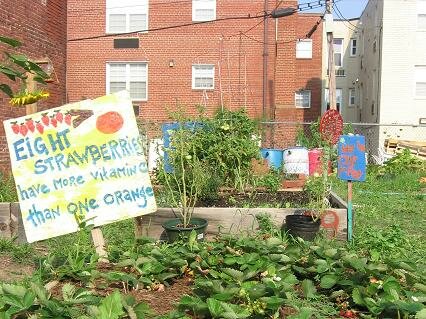by Kendra Langdon Juskus
[Ed. note: This article is part of our weekly series of church activities, called Cultivating Community, published on Thursdays.]
One day this past summer, my husband and I traveled to church in a new way: by bike! Much to our surprise and delight, the ride was only eight minutes longer by bike than by car; we rode through beautiful, trail-accessible-only landscapes we had never seen before; and we got to see and greet fellow cyclists and pedestrians along the way, no longer being separated from them by the glass and steel of a car. Our adventure was greeted with enthusiasm by our church family, and several folks wanted to ride with us the next week.
The only trouble we had with our endeavor was finding a place to park our bikes once we reached the church. We had to settle for locking them to a couple of parking signs; not a secure choice. An estimated 1.5 million bikes are stolen in the U.S. every year.
Installing bike parking outside of our church buildings is a simple way to encourage the flourishing of healthy, local, clean-energy-using communities. This one act can reflect a front-porch ethic of hospitality within the church—a space that, much like a front porch, straddles the private and public arenas of life and community.
How do we reach someone’s front porch? We walk, jog, skateboard, rollerblade, or bike. Installing bike parking at our churches would encourage folks to do the same on their way to worship, making our churches more neighborly, and inviting more folks to casually saunter (or cycle) on over.
Installing bike parking at your church:
1. Plan it: Once you have obtained approval for bike parking from the appropriate governing body at your church, you may want to check with your local government to see if it has recommendations for installing bike racks, or even the ability to provide you with funding or installation assistance. Some municipalities will even do the complete installation free-of-charge, in which case, your reading ends here!
2. Place it: You ensure use of a bike rack by placing it in a premium location. Factors to consider when determining that location include: access/visibility, security, weather, and pedestrian and automobile interference:
- Access/Visibility – Be sure to locate your bike rack in an area where cyclists (and potential cyclists) will see it and be able to reach it easily, without having to maneuver around too many obstacles like landscaping, parked cars, or signs. Be sure the rack is placed far enough from walls or other immovable objects for bikes to fit in the space comfortably, yet near to the building entrance cyclists will use. A parked bike will likely take up 72 inches of space along its side, and 24 inches of space across its front or back.
- Security – If the bike parking is located in an easily accessible and visible area, it is likely also in a location that is fairly secure, just by virtue of its visibility. However, providing secure bike parking may also include providing good lighting so that cyclists feel safe when parking at night.
- Weather – If possible, locate the parking under an already existing overhang or awning to protect bikes in inclement weather.
- Pedestrian and Automobile Interference – Ensure that the bike rack parking will be placed in an area that is not only free from obstructing objects, but also not dangerously close to automobile traffic, and not annoyingly close to pedestrian traffic (the post-church exit from the front doors, for instance!). Keep in mind that cyclists will need some room to bend down and lock or unlock their bikes, so give them that safe space!
3. Find it: Bike racks come in all shapes and sizes! Check with your local government to find out if there is a particular kind of rack required in your area. If not, consider the following when choosing appropriate parking (from bicyclinginfo.org, a helpful resource to use when starting this venture):
- The rack or stand should support the frame of the bicycle and not just one wheel. This makes parking more secure, as both the front wheel and frame of a bicycle should always be locked.
- The rack or stand should allow the frame and both wheels to be locked to the rack if the front wheel is removed or if both wheels remain on the bike. Sometimes cyclists remove their front wheel and lock both wheels and the bike frame to the rack for extra security.
- The rack should have space and shape to allow the use of either a cable or U-shaped lock.
- You should be able to securely anchor the rack into the pavement beneath it, preferably with tamper-proof bolts.
- The rack or stand should have space be usable by a variety of sizes and types of bicycles, including bikes with no kickstands or bikes with water bottle cages
The city of Chicago also has a bike-parking manufacturer’s guide available for your reference.
4. Use it: It’s important to publicize the bike rack or stand’s existence to your church community. Place a note about it in the church’s bulletin or other communication materials, have a ribbon-cutting ceremony, or start up a group of cyclists from within your church to both grow in fellowship and encourage the use of your new bike rack!
Related Posts at Flourish
Don’t Walk Alone: Doing walkability audits as a church community by Kendra Langdon Juskus
Front Porch Revival: The Past, Present, and Possibility of a Neighborhood Mainstay by Kendra Langdon Juskus
Liveability, Walkability, and Environmental Justice by Rusty Pritchard
Further Reading
bicyclinginfo.org – A great source of information on biking and “bikeability”
The International Bicycling Fund – A near-exhaustive resource for checking out almost any aspect of biking





{ 1 trackback }
{ 0 comments… add one now }